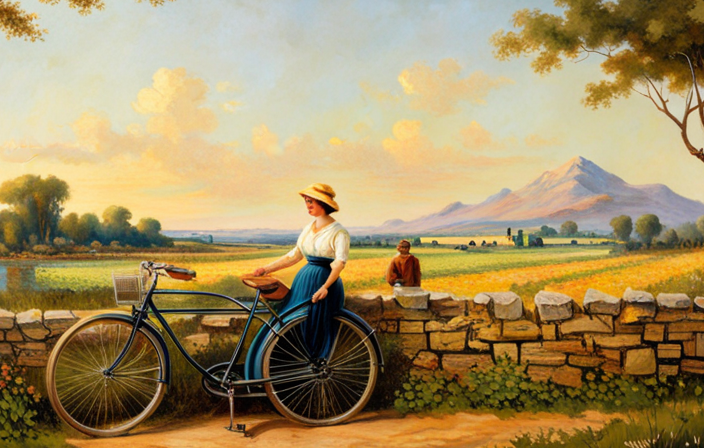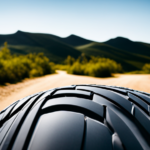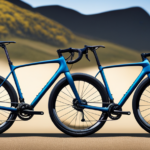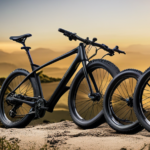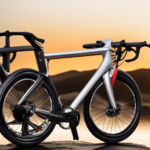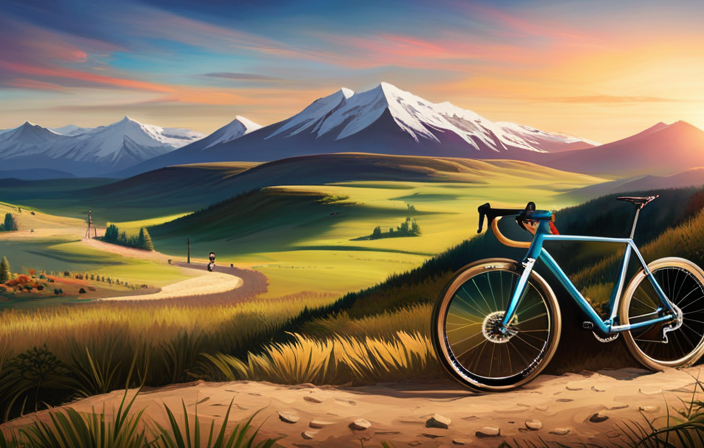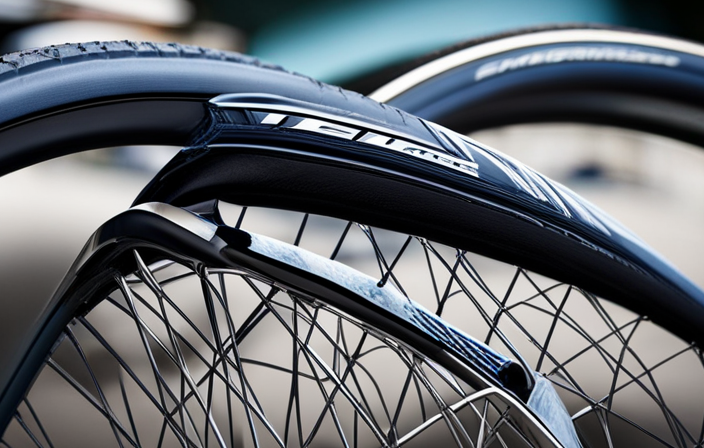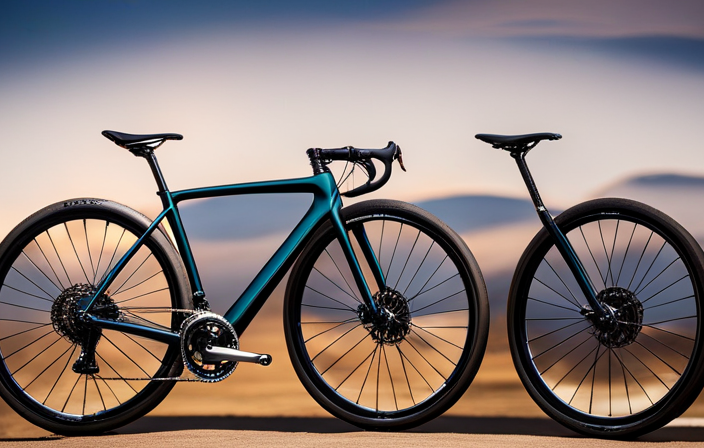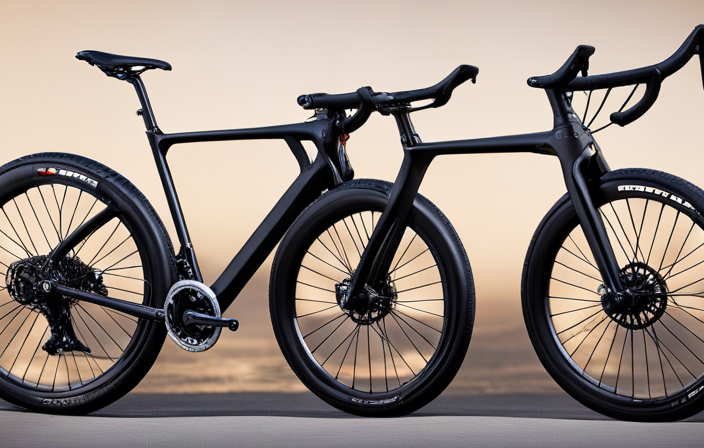Are you prepared to set off on monumental gravel journeys?
Well, get ready for a wild ride because we’re about to dive into the world of gravel bike tires. These bad boys are not your average rubber circles – they’re big, bold, and built for conquering rugged terrains.
In this article, I’ll take you through everything you need to know about how big gravel bike tires can get. Get ready to discover tire widths, diameters, treads, and more.
So buckle up and prepare to be amazed by the sheer size of these off-road beasts!
Key Takeaways
- Tire size is important in gravel biking for better traction, shock absorption, stability, and reduced skidding.
- Wider tires provide more stability and traction on rough terrains, but personal preference and frame clearance should be considered when choosing tire width.
- Common tire sizes for gravel bikes include 700c x 40mm, which is popular for mixed terrain.
- Wide tires offer a smoother ride on rough surfaces, better traction, lower tire pressures, and increased comfort, but they may not be as efficient on smooth pavement or for high-speed road cycling. Narrow tires, on the other hand, have less stability and traction on rough surfaces but lower rolling resistance and are suitable for smooth roads or hard-packed gravel paths.
The Importance of Tire Size in Gravel Biking
You’ll want to consider the importance of tire size when gravel biking. Understanding tire pressure and the benefits of wider tires can greatly enhance your riding experience on these rugged terrains.
When it comes to gravel biking, tire pressure plays a crucial role in determining your comfort and performance. Lower tire pressures provide better traction and shock absorption, allowing you to navigate through uneven surfaces with ease. Wider tires also contribute to this by providing a larger contact patch with the ground, increasing stability and reducing the chances of skidding or slipping.
The benefits of wider tires are numerous. Firstly, they offer improved grip on loose gravel, making it easier to maintain control while maneuvering through challenging terrain. Additionally, wider tires can absorb more impact from rough surfaces, resulting in a smoother ride that minimizes fatigue and discomfort.
Now that we’ve discussed the importance of tire pressure and the benefits of wider tires, let’s dive into understanding tire width and diameter. By having a deeper understanding of these aspects, you’ll be able to choose the right size that suits your specific needs without compromising performance or safety.
Understanding Tire Width and Diameter
When it comes to tire width and diameter, you might wonder what sizes are available for your gravel cycling adventures. Understanding tire width is crucial as it can greatly affect the performance and comfort of your ride. Gravel bike tires come in a variety of widths, ranging from narrower options around 28mm to wider ones exceeding 50mm. The advantage of wider tires is that they provide more stability and traction on loose or uneven surfaces, making them ideal for off-road conditions.
To help visualize the different tire widths available, here is a table showcasing some common options:
| Tire Width (mm) | Suitable Terrain |
|---|---|
| 28-32 | Smooth roads |
| 35-40 | Light gravel |
| 42-45 | Moderate gravel |
| Above 50 | Rough terrain |
As you can see, the wider the tire, the better it handles rougher terrains. However, it’s important to consider factors like frame clearance and personal preference when choosing your tire width.
With an understanding of tire width established, let’s dive into exploring common tire sizes for gravel bikes.
Common Tire Sizes for Gravel Bikes
To find the right fit for your gravel cycling adventures, commonly used tire sizes can help guide your decision. When it comes to gravel bike tires, there are a few standard sizes that riders tend to gravitate towards.
One of the most common sizes is 700c x 40mm, which strikes a good balance between speed and comfort on mixed terrain. This size provides enough volume to handle rough surfaces while still maintaining efficiency on smoother roads.
The importance of tire pressure cannot be overstated when it comes to gravel riding. Lower pressures can provide better traction and control on loose surfaces, but they also increase the risk of pinch flats or burping air out of tubeless setups. It’s important to find the right balance that works for you and the type of terrain you’ll be riding on.
One of the benefits of wider tires is their ability to absorb bumps and vibrations more effectively than narrower ones. This can lead to increased comfort during long rides, especially on rougher surfaces like gravel or dirt roads. Additionally, wider tires often allow for lower pressure without sacrificing performance, further enhancing their ability to smooth out the ride.
As we transition into discussing the pros and cons of wide tires, it’s important to consider how different tire widths can affect your overall riding experience.
Pros and Cons of Wide Tires
One advantage of wider tires is their ability to provide a smoother ride on rough surfaces. When compared to narrow tires, wide tires offer more cushioning and shock absorption due to their increased air volume. This allows them to roll over uneven terrain with greater ease, reducing the impact felt by the rider.
Additionally, wide tires have a larger contact patch with the ground, providing better traction and stability. They are particularly beneficial for gravel riding as they can handle loose or soft surfaces more effectively.
Wide tires also allow for lower tire pressures, which further enhances their performance on rough terrains. By running lower pressures, the tire conforms better to the surface irregularities, improving grip and comfort. This is especially advantageous when traversing rocky or bumpy trails where maintaining control and minimizing vibrations are crucial.
However, it’s important to consider that wide tires may not be suitable for all types of riding conditions. While they excel on loose gravel and off-road terrains, they may not be as efficient on smooth pavement or during high-speed road cycling. The increased rolling resistance of wider tires can make pedaling harder and reduce overall speed.
In conclusion, wide tires offer numerous benefits for gravel biking by providing a smoother ride on rough surfaces through improved cushioning, traction, and stability. However, there are pros and cons associated with both wide and narrow tire widths that should be considered based on the specific terrain you plan to ride on next.
Pros and Cons of Narrow Tires
A drawback of narrower tires is that they may offer less stability and traction on rough or loose surfaces. When riding on gravel or off-road trails, narrow tires can struggle to grip the terrain, making it harder to maintain control of the bike. Additionally, narrower tires have a smaller contact patch with the ground, which means they distribute the rider’s weight over a smaller area. This can lead to increased pressure on the tire and potentially cause it to sink into softer surfaces like mud or sand.
To illustrate the differences between narrow and wide tires, let’s compare them in a table:
| Narrow Tires | Wide Tires |
|---|---|
| Less stable | More stable |
| Decreased traction | Increased traction |
| Higher pressure on tire | Lower pressure on tire |
Choosing the right tire width depends on your riding style and preferences. If you primarily ride on smooth roads or hard-packed gravel paths, narrower tires may be suitable for you as they offer lower rolling resistance. However, if you frequently tackle rougher terrains or want more confidence and stability during your rides, wider tires are recommended.
In the next section about choosing the right tire size for your riding style, we will explore how different factors influence this decision.
Choosing the Right Tire Size for Your Riding Style
When it comes to gravel bike tires, there are several factors to consider in order to find the perfect fit for your riding style. In my previous subtopic, I discussed the pros and cons of narrow tires. Now, let’s dive into choosing the right tire size for your needs.
One important factor to consider is choosing the correct tire pressure. This can greatly impact your ride quality and performance on different terrains. Lower tire pressures provide better traction and a smoother ride on rough surfaces, while higher pressures offer increased speed on smoother roads.
Another consideration is whether to opt for tubeless tires. These have become increasingly popular among gravel riders due to their many benefits. Tubeless tires allow you to run lower pressures without worrying about pinch flats or punctures from thorns and rocks. They also provide a more supple ride by eliminating the friction between the tube and tire.
As we move forward into discussing factors to consider when selecting tire size, it’s important to keep in mind that finding the right fit involves a careful balance between comfort, traction, and speed.
Factors to Consider When Selecting Tire Size
To choose the right tire size for your riding style, consider factors such as terrain, comfort, and traction. The impact of tire size on comfort cannot be overstated. A wider tire provides more cushioning and absorbs shocks better than a narrower one. This is especially important when riding over rough or uneven surfaces commonly found on gravel roads. The larger volume of air in a wider tire acts as a natural suspension system, smoothing out the ride and reducing fatigue on long rides.
Additionally, there is a direct relationship between tire size and traction. A wider tire offers a larger contact patch with the ground, resulting in increased grip and stability. This becomes crucial when navigating loose gravel or slippery conditions. The added surface area allows for more aggressive cornering without sacrificing control.
When selecting the appropriate tire size, take into account your personal preferences and the type of terrain you will be riding on most frequently. If comfort is your priority, opt for wider tires that provide ample cushioning. Conversely, if speed is your main focus, narrower tires may be more suitable.
Considering these factors will help you make an informed decision about which tire size best suits your needs. Now let’s move on to some tips for maintaining and caring for gravel bike tires…
Tips for Maintaining and Caring for Gravel Bike Tires
To keep your gravel bike tires in good condition, it’s important to regularly inspect them for any signs of wear or damage. Maintaining tire pressure is crucial for optimal performance and longevity.
Here are some tips to help you maintain and care for your gravel bike tires:
-
Check tire pressure regularly: Keep a close eye on the tire pressure and make sure it is within the recommended range. Low tire pressure can lead to increased rolling resistance and a higher risk of pinch flats, while high pressure can result in a harsh ride and reduced traction.
-
Inflate tires with care: Use a reliable pump with an accurate gauge to inflate your gravel bike tires. Avoid overinflating as it can cause the tires to become too rigid and increase the chances of punctures.
-
Inspect for cuts or sharp objects: Regularly inspect your tires for any cuts, embedded debris, or sharp objects that could potentially cause punctures. Remove any foreign objects carefully using pliers or tweezers.
-
Rotate your tires: To ensure even wear across all areas of the tire tread, rotate them periodically. This will help prolong their lifespan and maintain consistent performance.
-
Clean your tires after muddy rides: Gravel biking often involves riding through muddy terrains. After such rides, make sure to clean off any mud or dirt from your tires using water and a gentle brush. This will prevent debris buildup that could affect traction or cause damage over time.
Maintaining proper tire pressure and preventing punctures are essential aspects of caring for gravel bike tires. By following these tips, you can enjoy better performance on your rides while ensuring the longevity of your tires.
Moving on to the next section about ‘the role of tire pressure in performance’, let’s dive deeper into how maintaining adequate tire pressure impacts overall riding experience.
The Role of Tire Pressure in Performance
Make sure you understand the role of tire pressure in performance to optimize your riding experience. Tire pressure plays a crucial role in gravel bike performance, affecting rider comfort, traction, and stability. Finding the right tire pressure can greatly enhance your overall ride quality.
When it comes to rider comfort, tire pressure is a key factor. Maintaining an optimal tire pressure helps absorb road vibrations and impacts, providing a smoother ride. Too high or too low tire pressure can result in uncomfortable rides, with increased jolts and bumps.
Additionally, tire pressure has a significant impact on traction and stability. Higher pressures provide better rolling efficiency on firm surfaces but sacrifice grip on loose terrain. On the other hand, lower pressures increase traction by allowing the tires to conform to irregular surfaces but may feel sluggish on smooth roads.
To help visualize the effect of tire pressure on performance, consider this table:
| Tire Pressure | Rider Comfort | Traction | Stability |
|---|---|---|---|
| High | Decreased | Increased | Decreased |
| Low | Increased | Decreased | Increased |
Understanding how different tire pressures impact rider comfort, traction, and stability is essential for optimizing your gravel biking experience.
The subsequent section will explore the relationship between tire size and bike handling without missing a beat.
The Relationship Between Tire Size and Bike Handling
Adjusting the size of your tires can have a significant impact on how your bike handles. When it comes to gravel bikes, tire size plays a crucial role in determining how well your bike performs on different terrains.
One key factor to consider is tire pressure. By adjusting the pressure, you can fine-tune the handling characteristics of your bike. Lower pressures provide better traction and a smoother ride on rough surfaces, while higher pressures offer less rolling resistance on smooth roads.
Another important aspect is tire tread. The tread pattern affects how the tire grips the ground, especially in wet or muddy conditions. Gravel-specific tires often have wider knobs and more aggressive tread patterns compared to road tires. This helps improve traction and stability when riding off-road.
It’s essential to find the right balance between tire pressure and tread for optimal performance. Experimenting with different combinations can help you find what works best for your riding style and local terrain.
Understanding how tire size affects bike handling is just one piece of the puzzle. In the next section, we’ll explore how tire size also influences speed and efficiency without sacrificing control or comfort.
How Tire Size Affects Speed and Efficiency
Changing the size of your tires can have a direct impact on how fast and efficiently you ride. When it comes to speed and efficiency, tire size plays a crucial role in determining your performance on gravel roads.
The impact of tire size on comfort and stability is significant. Larger tires, such as 40mm or wider, provide more cushioning and absorb vibrations better than smaller ones. This results in a smoother ride, especially on rough terrain. However, there is a trade-off between tire size and maneuverability. Smaller tires offer quicker handling and responsiveness, making it easier to navigate tight corners and switchbacks.
To help visualize this trade-off, consider the following table:
| Tire Size (mm) | Comfort | Stability | Maneuverability |
|---|---|---|---|
| 32 | Low | Low | High |
| 40 | High | High | Low |
As you can see from the table above, larger tires prioritize comfort and stability at the expense of maneuverability.
Exploring different tire treads and patterns can further enhance your riding experience. By choosing the right combination of tire size and tread design, you can optimize both speed and handling for your specific riding style.
With an understanding of how tire size affects speed and efficiency, let’s now delve into exploring different tire treads and patterns in order to maximize our gravel biking experience.
Exploring Different Tire Treads and Patterns
Now that we’ve discussed how tire size affects speed and efficiency, let’s delve into the world of tire treads and patterns.
When it comes to gravel biking, exploring different tire compounds can make a significant difference in performance. Tire compounds refer to the type of rubber used in the tires, which can vary in hardness and grip. Some tires are designed with softer compounds for enhanced traction on loose surfaces, while others prioritize durability for longer rides.
Another aspect to consider is the choice between tubeless and tubed tires. Tubeless tires have gained popularity in recent years due to their ability to run at lower pressures without the risk of pinch flats. This allows for better comfort and increased grip on rough terrain. On the other hand, tubed tires offer ease of maintenance as they can be easily patched or replaced if punctured.
Exploring different tire treads and patterns along with comparing tubeless versus tubed tires will help you find the perfect combination for your riding style and terrain preference.
So now that we have covered this aspect, let’s move on to discussing when and why you should consider upgrading your tires for an even better gravel biking experience.
Upgrading Your Tires: When and Why
If you’re looking to enhance your gravel biking experience, it’s worth considering when and why upgrading your tires can make a difference.
Upgrading options for gravel bike tires are plentiful, offering various benefits that can greatly improve your ride. Here are some reasons why upgrading might be a good idea:
-
Increased traction: Upgrading to tires with a more aggressive tread pattern can provide better grip on loose or muddy terrain, giving you the confidence to tackle challenging conditions.
-
Improved puncture resistance: Some upgraded tires come with added layers of protection against flats, reducing the chances of getting stranded in remote areas.
-
Enhanced rolling efficiency: Upgrading to lighter and faster-rolling tires can help you maintain momentum and speed on gravel roads, making your rides more enjoyable.
-
Longer lifespan: Investing in high-quality tires with improved durability can save you money in the long run by lasting longer and requiring fewer replacements.
Considering these factors, upgrading your gravel bike tires is a decision that should not be taken lightly. It’s important to weigh the benefits against any potential drawbacks such as increased cost or changes in ride quality.
Now let’s explore expert recommendations for gravel bike tire sizes.
Expert Recommendations for Gravel Bike Tire Sizes
Expert recommendations for tire sizes on gravel bikes typically suggest finding a balance between width and tread pattern for optimal performance. When it comes to gravel riding, understanding tire pressure and the benefits of tubeless tires is crucial. A wider tire provides more stability and traction on loose surfaces, while a narrower tire offers lower rolling resistance on smoother terrain.
To help you better visualize the options available, here is a table showcasing some common gravel bike tire sizes:
| Tire Size | Width (mm) | Recommended Terrain |
|---|---|---|
| 700x35c | 35 | Mixed surfaces |
| 650B x 47c | 47 | Rougher terrain |
| 700x40c | 40 | Gravel roads |
| 650B x 42c | 42 | Versatile |
| 700x45c | 45 | Off-road adventures |
Understanding your preferred riding style and the terrain you’ll be encountering will help guide your decision. Additionally, many riders are opting for tubeless tires due to their ability to run lower pressures without risking pinch flats. This allows for increased comfort and improved traction.
In conclusion, finding the perfect tire size for your gravel adventures involves considering factors such as width, tread pattern, understanding tire pressure, and the benefits of tubeless tires. By taking these recommendations into account, you can enhance your overall riding experience on varied terrains.
Conclusion: Finding the Perfect Tire Size for Your Gravel Adventures
To find the perfect tire size for your gravel adventures, consider factors such as your preferred riding style and the terrains you’ll be tackling. Gravel bike tires come in a range of sizes, and finding the right one can greatly enhance your riding experience.
When it comes to tire pressure, it’s important to strike a balance between comfort and performance. Lower pressures provide better traction on loose surfaces, but they can increase the risk of pinch flats. On the other hand, higher pressures reduce rolling resistance on smooth roads but can result in a harsher ride on rough terrain.
When comparing tubeless and tubed tires, there are several factors to consider. Tubeless tires have become increasingly popular in recent years due to their ability to run at lower pressures without risking pinch flats. They also offer better puncture resistance since there is no inner tube that can be punctured by sharp objects. However, tubeless setups require specific rims and sealant for proper installation.
In conclusion, finding the ideal tire size for your gravel adventures involves considering your riding style and the terrains you’ll be encountering. Additionally, comparing tubeless and tubed tires can help you make an informed decision based on factors such as puncture resistance and ease of installation. By carefully evaluating these aspects, you can ensure that your gravel bike is equipped with the perfect tires for your needs.
Frequently Asked Questions
Can I use mountain bike tires on a gravel bike?
Yes, you can use mountain bike tires on a gravel bike. Mountain bike tires have certain advantages, such as providing better traction and stability on rough terrains due to their aggressive tread patterns.
However, when considering using mountain bike tires on a gravel bike, it’s important to take into account the specific needs of gravel riding. Gravel bike tires are typically wider and have lower pressure for improved comfort and control on loose surfaces while still maintaining good rolling efficiency.
What is the maximum tire width that can fit on a gravel bike?
To determine the maximum tire width that can fit on a gravel bike, I investigated various sources and consulted with experts in the field.
Gravel bikes typically have tire clearances ranging from 35mm to 50mm, but some models can accommodate even wider tires.
The advantages of wider tires include increased traction, improved stability, and enhanced comfort when riding off-road or on rough terrain.
It’s important to check your specific bike’s specifications for precise compatibility.
Are wider tires better for gravel biking?
Wider tires are generally considered better for gravel biking. They provide better traction on uneven surfaces, such as gravel roads, allowing for a more stable and controlled ride. Narrower tires may be more efficient on smooth pavement, but when it comes to off-road riding, wider tires offer increased stability and grip.
They can handle rough terrain with ease, absorbing impact and reducing the risk of punctures. Overall, wider tires are a popular choice among gravel bikers for their superior performance on challenging surfaces.
How do tire pressure and tire size affect the comfort of a gravel bike ride?
The tire pressure and size greatly impact the comfort of a gravel bike ride. Adequate tire pressure is crucial for optimal performance, as it affects traction, rolling resistance, and overall control. Lower pressure provides more grip and cushioning on rough terrain, enhancing comfort.
Additionally, tire size plays a significant role in gravel bike comfort. Wider tires offer better stability and absorb more vibrations, resulting in a smoother and more enjoyable riding experience over varied off-road surfaces.
Can I switch between different tire sizes depending on the terrain I’m riding on?
Yes, you can switch between different tire sizes depending on the terrain you’re riding on.
When it comes to switching tire sizes on a gravel bike, there are a few factors to consider.
First, the width of the tire will affect your traction and stability on different surfaces. A wider tire provides more grip on loose or uneven terrain, while a narrower tire is better for smoother roads.
Additionally, the tread pattern can also impact how well your tires perform in different conditions.
So, when selecting tires for specific terrains, it’s essential to choose the right size and tread pattern that suits your riding needs.
Conclusion
In conclusion, finding the perfect tire size for your gravel adventures is crucial.
Whether you opt for wide or narrow tires, each has its own set of pros and cons.
Wide tires offer better stability and traction on rough terrain, while narrow tires provide a faster and more efficient ride on smoother surfaces.
It’s important to consider the type of terrain you’ll be riding on and choose a tire tread that suits your needs.
Ultimately, upgrading your tires can greatly enhance your gravel biking experience.
So go out there, explore new paths, and let the right tire size take you further than ever before!

